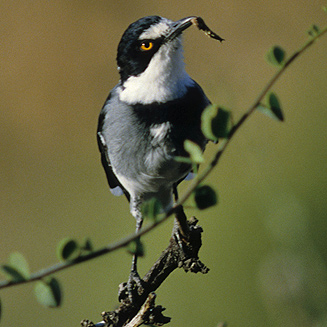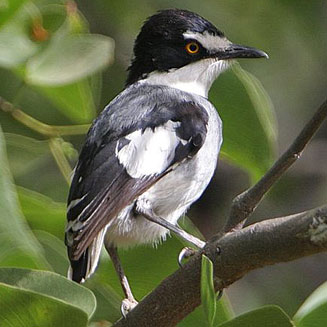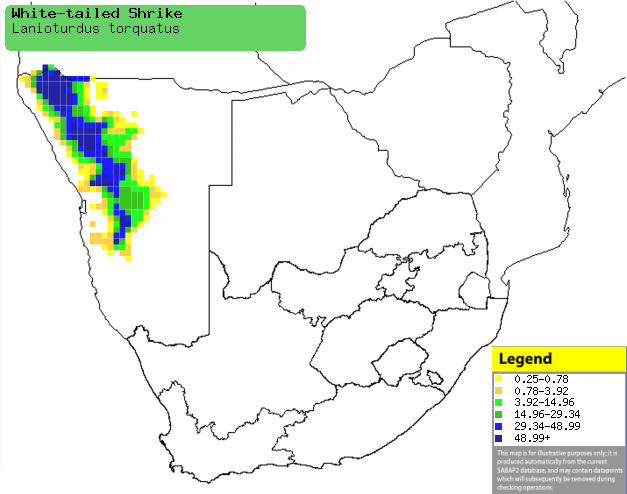|
Lanioturdus torquatus
(White-tailed shrike)
Kortstertlaksman [Afrikaans]; Tapuitklauwier [Dutch];
Lanielle à queue blanche [French]; Drosselwürger [German]; Picanço-palrador
[Portuguese]
Life
> Eukaryotes >
Opisthokonta
> Metazoa (animals) >
Bilateria >
Deuterostomia > Chordata >
Craniata > Vertebrata (vertebrates) > Gnathostomata (jawed
vertebrates) > Teleostomi (teleost fish) > Osteichthyes (bony fish) > Class:
Sarcopterygii (lobe-finned
fish) > Stegocephalia (terrestrial
vertebrates) > Tetrapoda
(four-legged vertebrates) > Reptiliomorpha > Amniota >
Reptilia (reptiles) >
Romeriida > Diapsida > Archosauromorpha > Archosauria >
Dinosauria
(dinosaurs) > Saurischia > Theropoda (bipedal predatory dinosaurs) >
Coelurosauria > Maniraptora > Aves
(birds) >
Order: Passeriformes
> Family: Malaconotidae
 |
 |
|
White-tailed shrike. [photo Peter Steyn
©] |
White-tailed shrike, Kunene River Lodge, Namibia. [photo
Trevor Hardaker ©] |
Distribution and habitat
Near-endemic to northern and central Namibia, extending
marginally into south-western Angola. Its habitat preferences vary from region
to region, e.g. in in northern Namibia, it prefers Colosphermum mopane
(Mopane) woodland. In west-central Namibia, it is most common in mixed
Acacia, cluster-leafs (Terminalia) and bushwillow (Combretum)
woodland.
|
 |
|
Distribution of White-tailed shrike in southern Africa,
based on statistical smoothing of the records from first SA Bird Atlas
Project (©
Animal Demography unit, University of
Cape Town; smoothing by Birgit Erni and Francesca Little). Colours range
from dark blue (most common) through to yellow (least common). |
Food
It mainly eats large insects, doing most of its foraging at
dawn or dusk, gleaning insects off leaves and branches and occasionally flying
to the groud to pick up a prey item. It very rarely drinks or bathes in water,
in fact even thought it has been studied and observed many times, there is only
one recorded of it drinking water! The following food items have been recorded
in its diet:
Breeding
- The nest is a shallow cup of woven twigs and rootlets, usually placed in
small thicket or bush about 2-3 metres above ground.
- Egg-laying season is almost year round, usually peaking around November.
- It lays about 2 eggs which are incubated by both sexes, singing a duet
whenever they change shifts.
Threats
Not threatened.
References
-
Hockey PAR, Dean WRJ and Ryan PG 2005. Roberts
- Birds of southern Africa, VIIth ed. The Trustees of the John Voelcker
Bird Book Fund, Cape Town.
|
